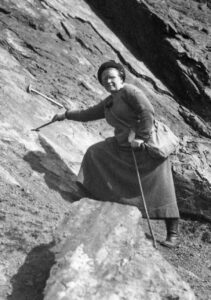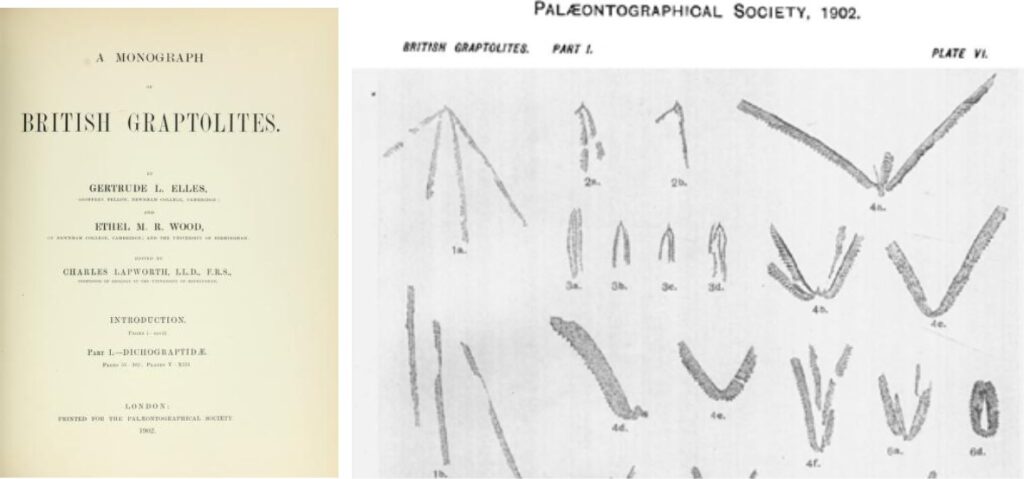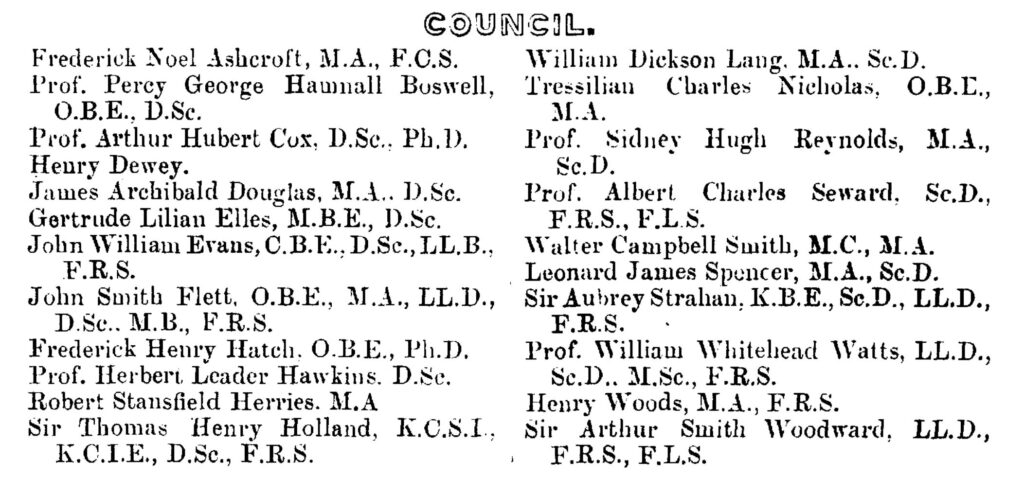
This biography is part of the series Pioneering women in Earth Sciences – the link will take you to the main page.
Gertrude Elles was one of those indefatigable Victorian and post-Edwardian women who’s influence on British science and British university system still resonates. She became was held in high regard at Newnham College (her alma mater) and Cambridge University, although she may have been a bit too forthright for some of her male colleagues.
Her central claim to scientific recognition is the joint Monograph of British Graptolites with Ethel Wood, the first comprehensive compilation of a fossil group that is fundamental to unravelling Ordovician and Silurian stratigraphy. In fact, the Elles-Wood syntheses, along with those by Margaret Crosfield and Ethel Wood, were keys that helped unlock Charles Lapworth’s 1879 proposal that placed the Ordovician Period between the Cambrian and Silurian. The Monograph is still cited today.

But Gertrude Elles was much more than a paleontologist. She was an influential and fierce advocate for the place of women in science and higher education, someone who immersed herself in the greater scientific community (in various societies), and an advocate for field work as an essential part of geological learning. Her insistence on the centrality of field work is exemplified in her 1931 paper “The study of geological maps.”
Some of her achievements are listed below in approximate chronological order. Most of the information in the list has been gleaned from J. Tubb and C.V. Burek (2021, OA).
Career timeline
1891 Began studies in Natural History at Newnham College, Cambridge University, where she met Margaret Crosfield, Ethel Shakespear (née Wood), and Ethel Woods (nee Skeat) who became lifelong friends and colleagues.
1895 Passed with Honours the Natural History Tripos exam but at that time Cambridge University, like Oxford, did not grant degrees to women – a situation that was rectified more than 50 years later in 1948. The Tripos was a Cambridge University examination system that allowed students to qualify for a Bachelor degree but only if you were a male.
1896 Gertrude Elles was one of the first women to join the Sedgwick Club at Cambridge. The club is run by undergraduate students; it is the world’s oldest student-led club, established in 1880. She was a member for 67 years, and a role model for other women students who joined.
1900 Elles was awarded the Lyell Fund from the Geological Society of London so she could continue her research, but she was not permitted to collect it in person. This was done on her behalf by Cambridge Professor Thomas Hughes.
1901 On Charles Lapworth’s advice, Elles began working on British graptolites – an investigation that would last several years and become the cornerstone of her reputation as a scientist. Her investigations coordinated with colleagues Crosfield, Shakespear, and Woods who began working on Ordovician-Silurian stratigraphy and the Cambrian-Silurian problem.
1903 She became Assistant Demonstrator at the Sedgwick Museum, Cambridge University.
1905 Elles earned a DSc from Trinity College, Dublin as part of the group of women known as the Steamboat Ladies. This was the only pathway for women who had completed degree programs at Cambridge and Oxford to gain bona fide degrees. The program also permitted Cambridge and Oxford to continue their policy of not granting women degrees, even though they were allowed to study at these institutions.
1901-1914 Elles and Ethel Wood wrote 10 articles or chapters for what would eventually become their Monograph of British Graptolites, published by the Palaeontographical Society. The title page was added in 1918. The editor for all the articles was Charles Lapworth.
1914-1918 Elles was a Commandant at a Red Cross hospital for wounded soldiers in Cambridge during World War I.
1919 She was the first woman to be awarded the Murchison Medal from the Geological Society in recognition of her work on graptolites and Lower Paleozoic stratigraphy.
That same year she was in the group of eight women who were the first females to be elected as Fellows of the Geological Society.
1920 She was awarded an MBE (Member of the British Empire) for her war service. The Grand Master of awards like this is the current Monarch of the United Kingdom.
1923 Elected President of the British Association for the Advancement of Science.
1923-27 First woman elected to the Geological Society of London Council

1925-1926 Elles becomes Vice Principal at Newnham College.
1926 First woman lecturer at Cambridge University, teaching both women and men.
1936 First woman to be granted a Readership at Cambridge University.
1948 Women were finally granted degrees at Cambridge and Oxford. Elles gained her PhD in 1949 at age 77.
2018 The Palaeontological Association establishes the Gertrude Elles Award to promote public engagement in science.
References and other documents
Charles Lapworth, 1879. On the tripartite classification of the Lower Palaeozoic rocks. Geological Magazine, 6, 1–15. Internet Archive
Gertrude L. Elles and Ethel M. R. Wood, 1902. A Monograph of British Graptolites; Part I. Dichograptidae. Palaeontographical Society. Available from the Biodiversity Heritage Library
Cynthia V Burek, 2009. ‘The first female Fellows and the status of women in the Geological Society of London’, Geological Society, London, Special Publications, 317, 373-407.
Cynthia V. Burek, 2014. The contribution of women to Welsh geological research and education up to 1920, Proceedings of the Geologists’ Association, Volume 125, Issue 4, p. 480-492.
Ferwen. 2016. Forgotten women of Paleontology, The Newnham Quartet: Gertrude Elles.
Paul Smith, 2018. Legends of Rock: Gertrude Elles. The Palaeontological Association, Newsletter No. 99.
Geological Society Blog, 2019. 100 years of female Fellows: Gertrude Lilian Elles.
J. Tubb and C.V. Burek (2021). Gertrude Elles: the pioneering graptolite geologist in a woolly hat. Her career, achievements and personal reflections from her family and colleagues. Geological Society, London, Special Publications, v. 506, pp. 157 – 169. Open Access.


















1 thought on “Gertrude Lilian Elles (1872-1960)”
This is insightful and also inspiring as a female geologist and scientist in a male dominated field. The need for field work and research cannot be overemphasized.